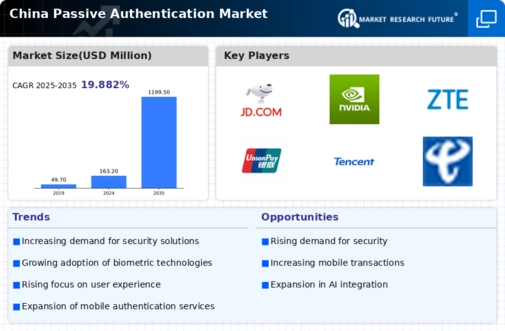Growing E-commerce Sector
The rapid expansion of the e-commerce sector in China is significantly impacting the passive authentication market. As online shopping continues to gain popularity, the need for secure and efficient authentication methods becomes paramount. In 2025, e-commerce sales in China are projected to reach approximately $2 trillion, highlighting the importance of protecting consumer data during transactions. Retailers are increasingly adopting passive authentication solutions to enhance security while providing a seamless shopping experience. This trend suggests that the passive authentication market will likely experience substantial growth as businesses seek to safeguard customer information and build trust in their online platforms.
Rising Cybersecurity Threats
The increasing frequency and sophistication of cyberattacks in China has heightened the demand for robust security measures, thereby driving the passive authentication market. Organizations are increasingly recognizing the need for seamless security solutions that do not disrupt user experience. In 2025, it is estimated that cybersecurity spending in China will reach approximately $30 billion, reflecting a growing commitment to safeguarding sensitive data. This trend suggests that businesses are likely to invest in passive authentication technologies to mitigate risks associated with unauthorized access and data breaches. As a result, The passive authentication market is expected to expand as companies enhance their security posture. This growth will occur while maintaining user convenience..
Increased Mobile Device Usage
The proliferation of mobile devices in China is a key driver of the passive authentication market. With over 1 billion smartphone users in the country, the demand for secure and efficient authentication methods is at an all-time high. Mobile applications are increasingly incorporating passive authentication features to streamline user access while ensuring security. In 2025, it is estimated that mobile payment transactions in China will exceed $5 trillion, further emphasizing the need for secure authentication solutions. This trend indicates that businesses are likely to invest in passive authentication technologies to enhance user convenience and security, thereby propelling the growth of the passive authentication market.
Advancements in Biometric Technologies
Technological innovations in biometric systems, such as facial recognition and fingerprint scanning, are significantly influencing the passive authentication market. In China, the integration of these technologies into various applications, including mobile payments and access control, is becoming increasingly prevalent. The market for biometric authentication is projected to grow at a CAGR of 20% from 2025 to 2030, indicating a strong shift towards more secure and user-friendly authentication methods. This growth is likely to encourage the adoption of passive authentication solutions that leverage biometric data, thereby enhancing security without compromising user experience. Consequently, the passive authentication market is poised for substantial growth as organizations embrace these advancements.
Government Initiatives for Digital Security
The Chinese government is actively promoting digital security initiatives, which are likely to bolster the passive authentication market. Policies aimed at enhancing cybersecurity and protecting personal data are being implemented, creating a favorable environment for the adoption of passive authentication technologies. In 2025, government spending on cybersecurity is expected to increase by 15%, reflecting a commitment to improving national security infrastructure. This focus on digital security may encourage businesses to invest in passive authentication solutions to comply with regulations and protect sensitive information. As a result, the passive authentication market is anticipated to grow in response to these government initiatives.

























Leave a Comment